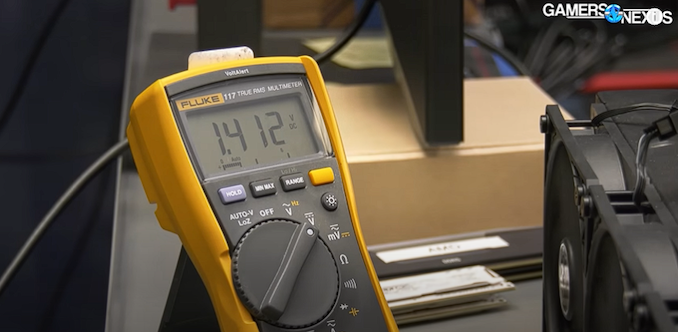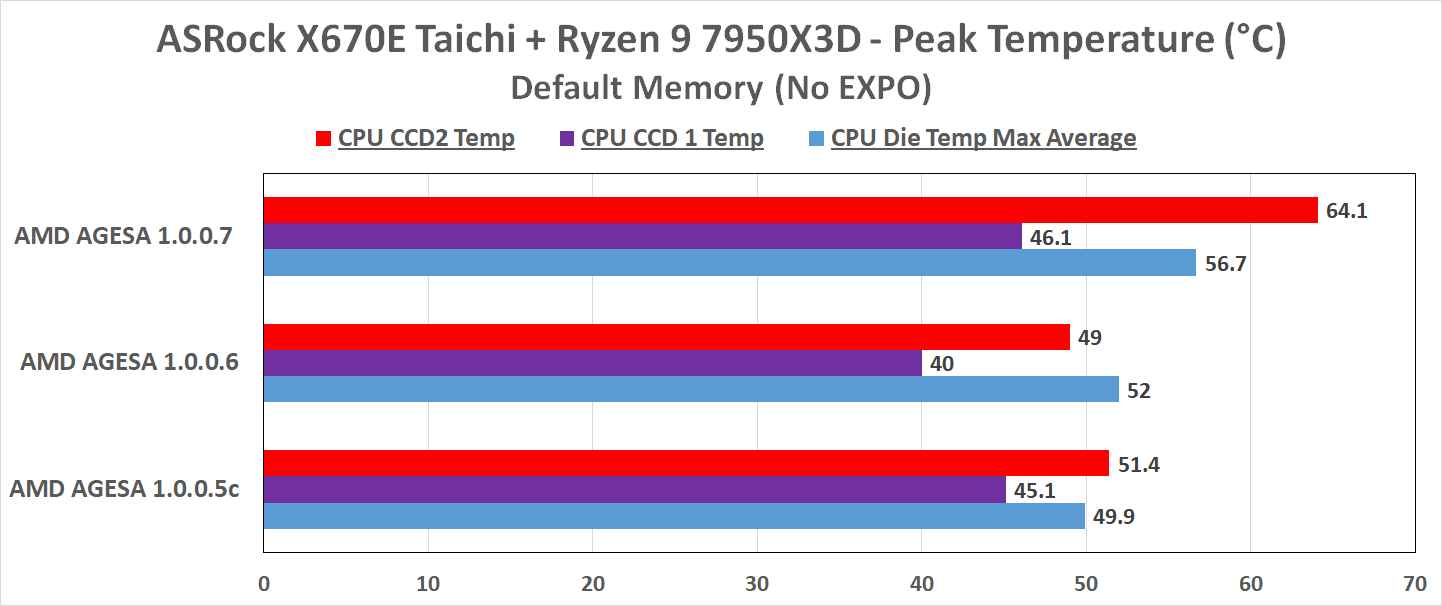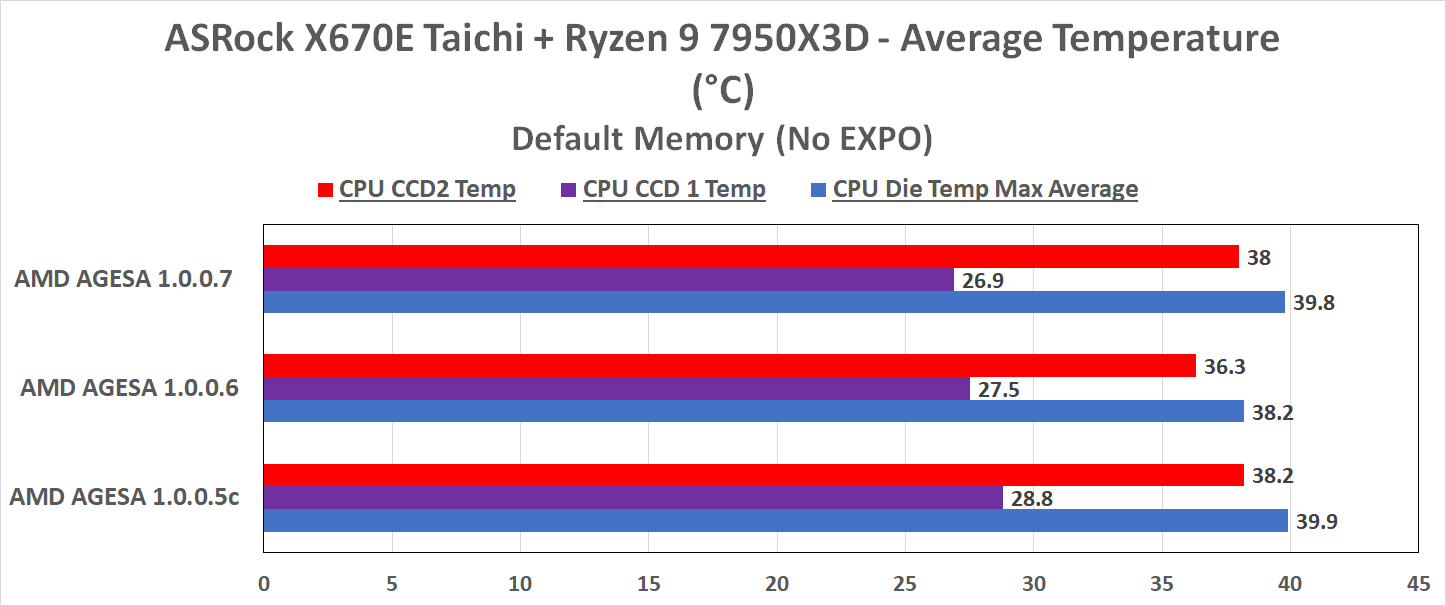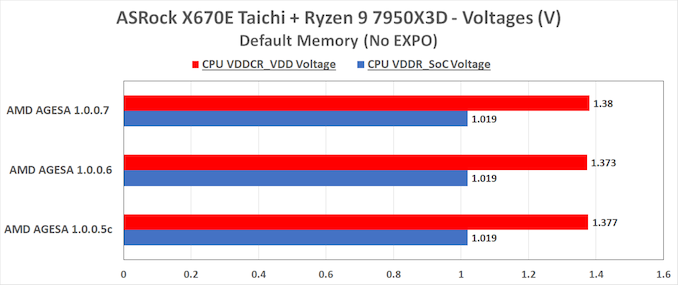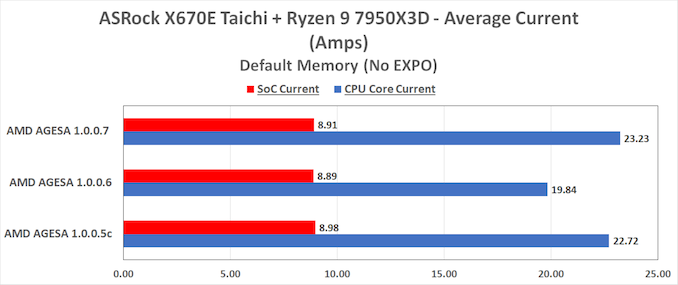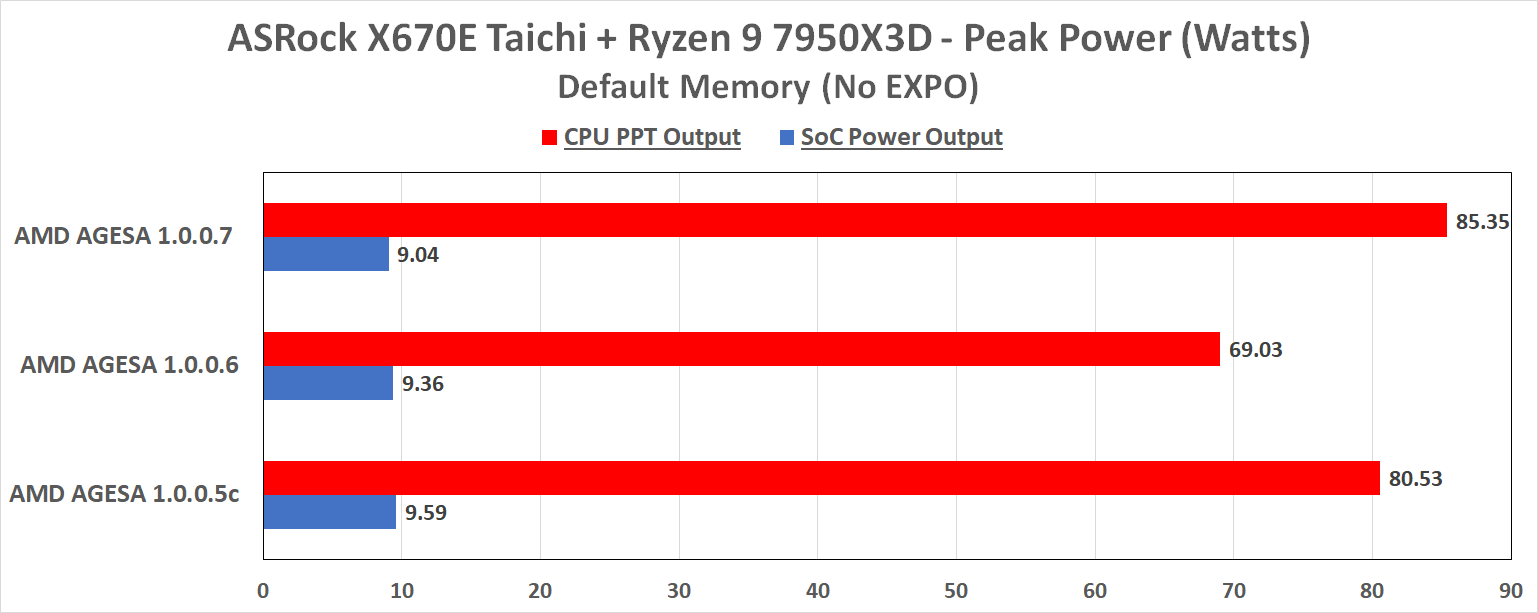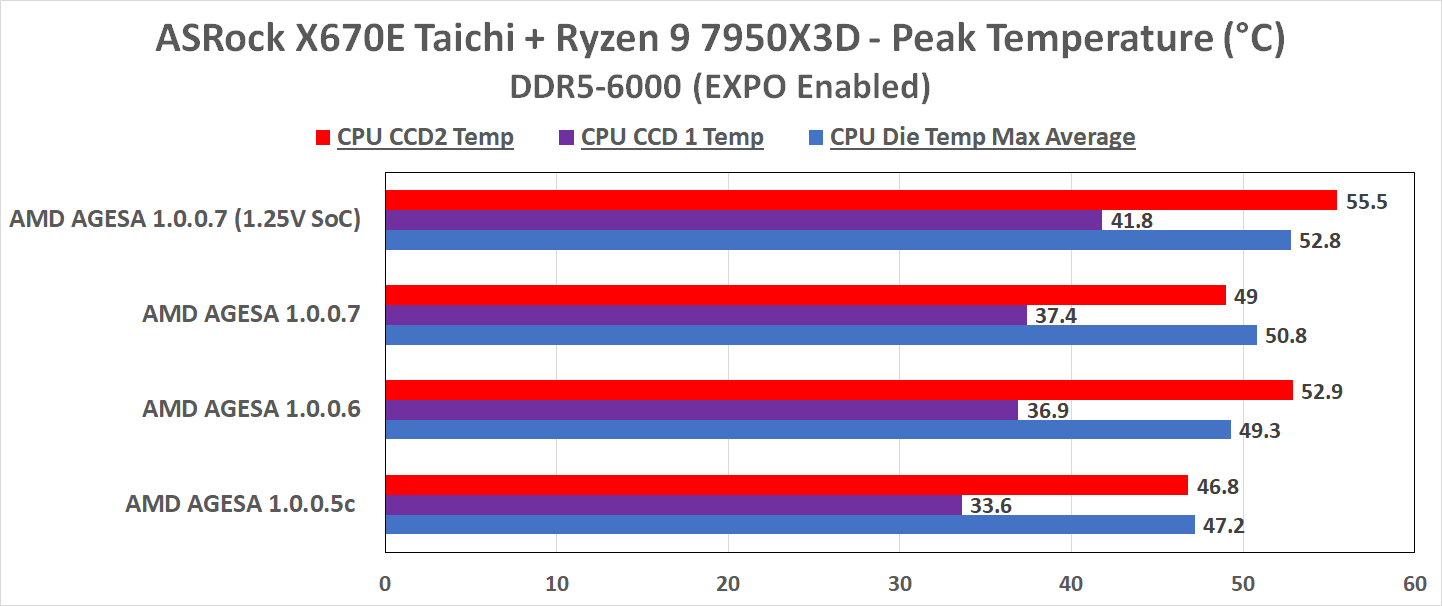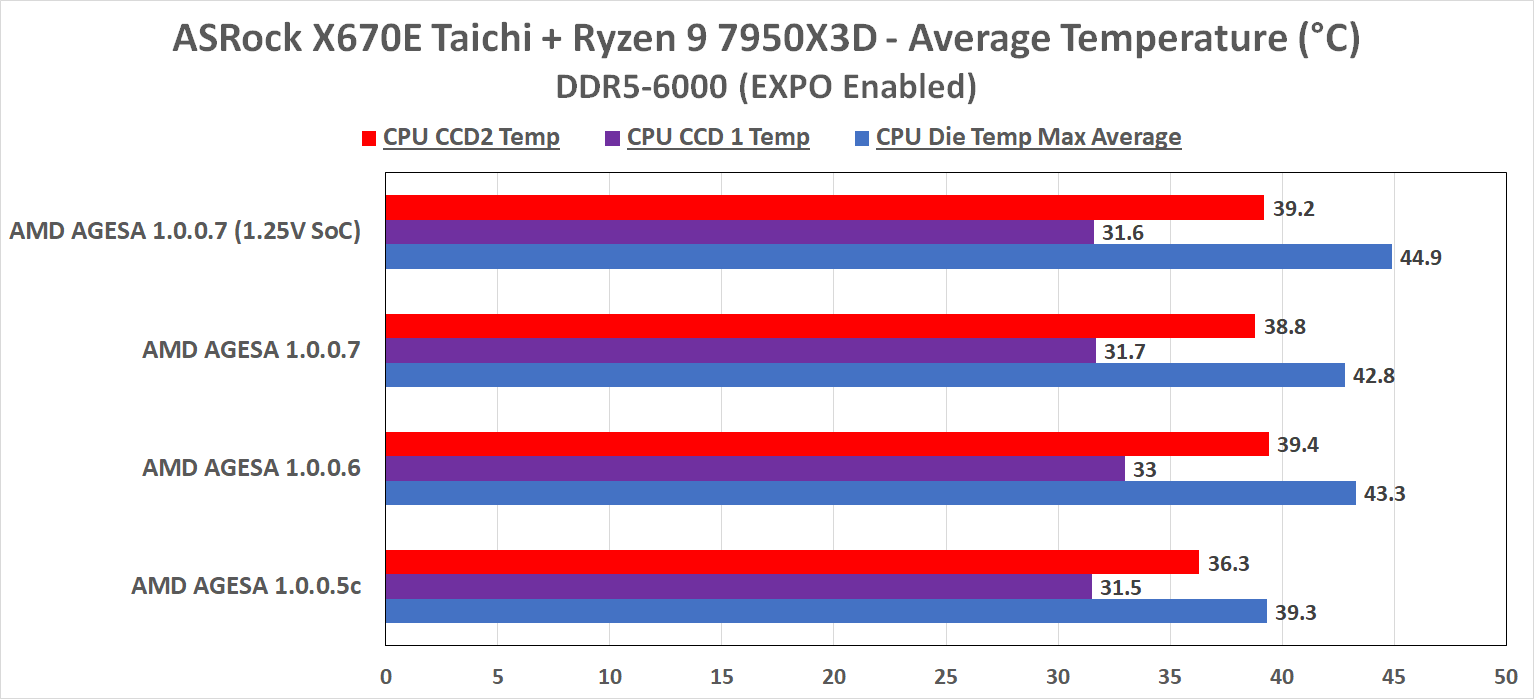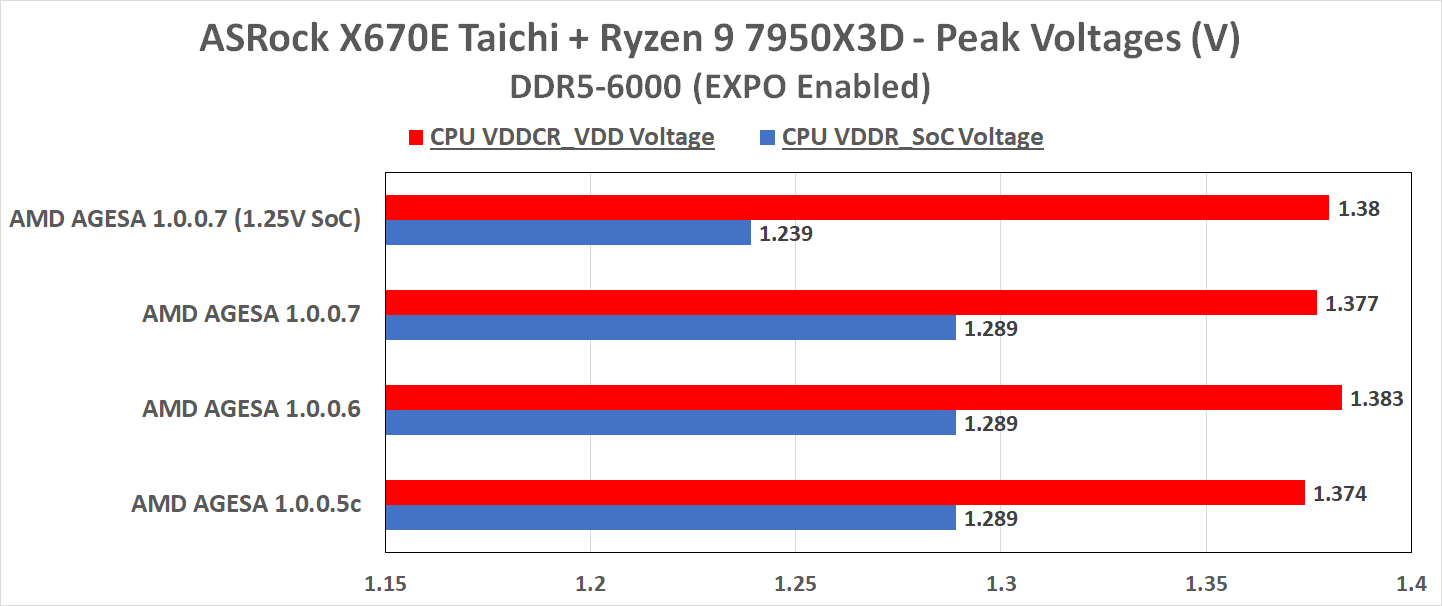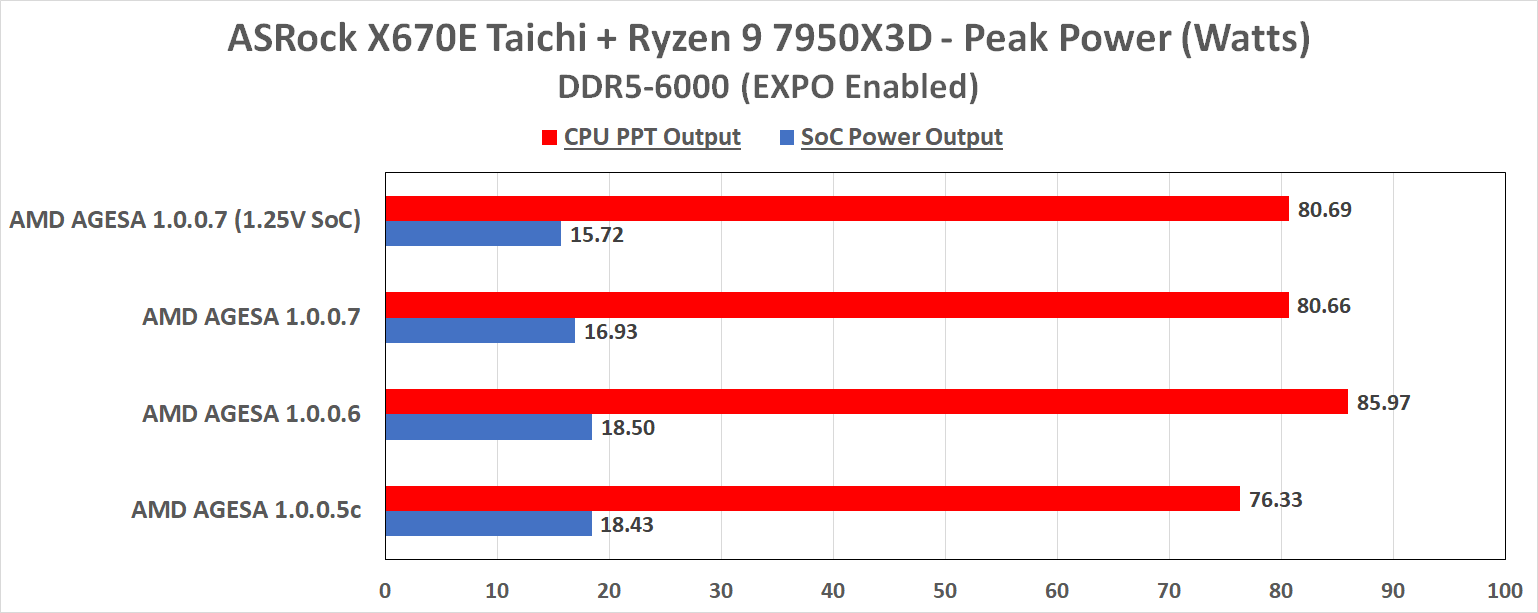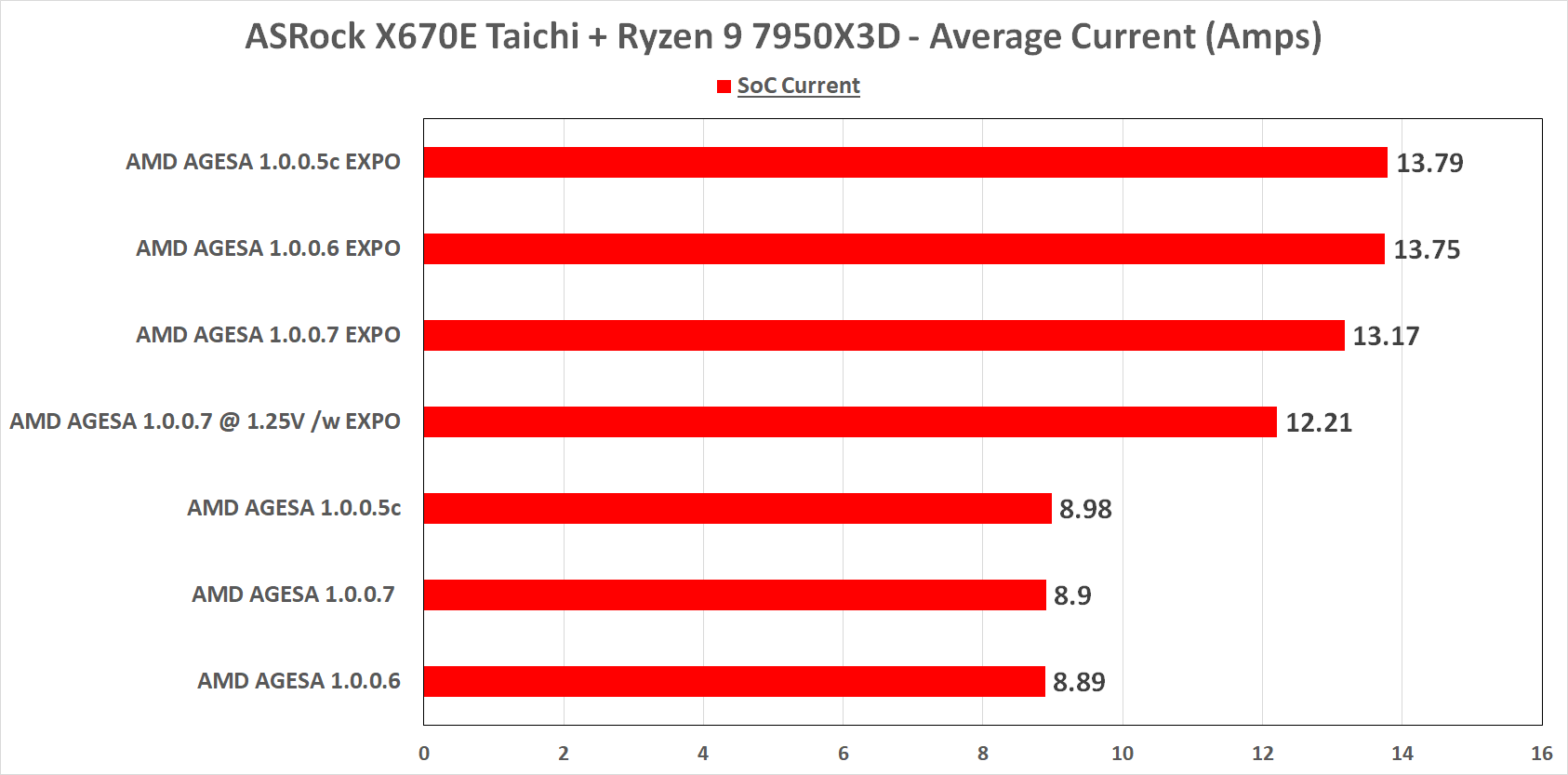
Original Link: https://www.anandtech.com/show/18847/voltage-lockdown-investigating-amd-agesa-1007-on-x670e-taichi
Voltage Lockdown: Investigating AMD's Recent AM5 AGESA Updates on ASRock's X670E Taichi
by Gavin Bonshor on May 16, 2023 12:00 PM EST- Posted in
- CPUs
- AMD
- ASRock
- Motherboards
- X3D
- Ryzen 7000
- X670E Taichi
- AGESA
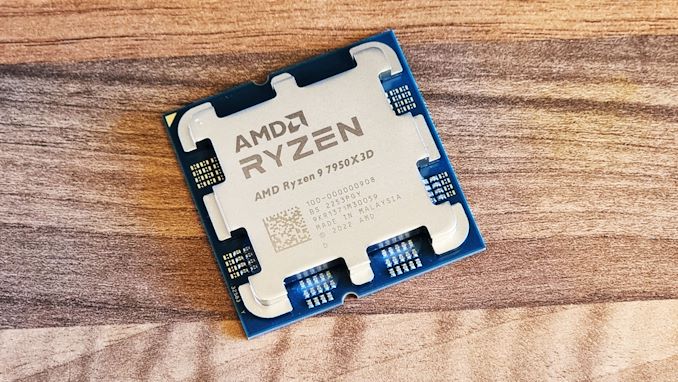
It's safe to say that the last couple of weeks have been a bit chaotic for AMD and its motherboard partners. Unfortunately, it's been even more chaotic for some users with AMD's Ryzen 7000X3D processors. There have been several reports of Ryzen 7000 processors burning up in motherboards, and in some cases, burning out the chip socket itself and taking the motherboard with it.
Over the past few weeks, we've covered the issue as it's unfolded, with AMD releasing two official statements and motherboard vendors scrambling to ensure their users have been updating firmware in what feels like a grab-it-quick fire sale, pun very much intended. Not everything has been going according to plan, with AMD having released two new AGESA firmware updates through its motherboard partners to try and address the issues within a week.
The first firmware update made available to vendors, AGESA 1.0.0.6, addressed reports of SoC voltages being too high. This AGESA version put restrictions in place to limit that voltage to 1.30 V, and was quickly distributed to all of AMD's partners. More recently, motherboard vendors have pushed out even newer BIOSes which include AMD's AGESA 1.0.0.7 (BETA) update. With even more safety-related changes made under the hood, this is the firmware update AMD and their motherboard partners are pushing consumers to install to alleviate the issues – and prevent new ones from occurring.
In this article, we'll be taking a look at the effects of all three sets of firmware (AGESA 1.0.0.5c - 7) running on our ASRock X670E Taichi motherboard. The goal is to uncover what, if any, changes there are to variables using the AMD Ryzen 9 7950X3D, including SoC voltages and current drawn under intensive memory based workloads.
Here is our recent coverage of the Ryzen 7000X3D/7000 'burnout' issues, including two statements from AMD, an official response from ASUS and MSI:
- MSI Addresses CPU Voltages on AM5 Motherboards for Ryzen 7000X3D Processors
- AMD Issues Official Statement on Reported Ryzen 7000 Burnout Issues
- ASUS Issues Statement on Ryzen 7000X3D Processor Issues, Possible Voltage Issues with AMD EXPO
- AMD Issues Second Statement on Ryzen 7000 Burnout Issues: Caps SoC Voltages
AMD Ryzen 7000 AGESA Firmware: From 1.0.0.5c to 1.0.0.7 Within 32 Days
The first firmware update made available to vendors, AGESA 1.0.0.6, addressed reports of SoC voltages being too high, with new restrictions put in place to limit things to 1.30 V. In the case of the board we've been using to try and dig deeper into issues, the ASRock X670E Taichi, this was made available to the public on 4/27/23 through its 1.21 firmware update. More recently, on 5/4/23, ASRock made its latest 1.24.AS02 firmware, which includes AMD's AGESA 1.0.0.7 (BETA) update.
The AGESA 1.0.0.7 (BETA) update is the firmware that AMD has been planning to roll out most recently to alleviate the issues of burnout, not just for Ryzen 7000X3D chips with 3D V-Cache, but also across the broader Ryzen 7000 and AM5 ecosystem. In between the initial AGESA 1.0.0.5c firmware that brought AMD's Ryzen 7000X3D support to AM5 motherboards, in the space of a mere 32 days, AMD has released a total of three major AGESA versions, which ASRock has dutifully published for the X670E Taichi. We'll be using this as our baseline for our analysis and look into what's going on.
On top of this, AMD is also planning to release an even more robustly updated AGESA firmware, which could be in the coming weeks. Referred to internally as AGESA 1.0.0.9, we did reach out to AMD for comment on this, but our rep couldn't comment on "unannounced or internal only software stacks." It should also be noted that the current firmware at the time of writing available to users is a BETA version, implying that a newer AGESA is undoubtedly on its way. Still, the timescale of the release is anyone's guess currently.
So looking at the variations in AMD's AGESA updates over the last month, there hasn't been any official indication of changes other than the bare minimum, at least not from ASRock's descriptions. The following is what ASRock is saying about the descriptions of the AGESA updates:
- AGESA 1.0.0.5c: Initial support for Ryzen 7000X3D processors with 3D V-Cache.
- AGESA 1.0.0.6 (BETA): Improved memory compatibility, Optimizations for Ryzen 7000X3D, recommended update for Ryzen 7000X3D processors.
- AGESA 1.0.0.7 (BETA): Support for 48/24GB DDR5 memory modules.
The description of the changes, at least from the point of ascertaining what each AGESA is offering, is borderline pitiful. In none of the descriptions does it state what changes AMD has made to each AGESA firmware to address the current issues, which in all honesty, is a pretty big thing to omit. There are no indications whatsoever on ASRock's X670E Taichi BIOS page as to what each firmware changes, and with no public notes available to users, it's a case of "update to this firmware, it's recommended."
So what do we know about the changes? Well, we know the critical change going from AGESA 1.0.0.5c to the 0.6 and 0.7 versions is a lockdown on SoC voltage to 1.30 V. Previously, on the ASRock X670E Taichi with 1.0.0.5c; we were able to set the SoC voltage to 2.5 V, which would almost certainly result in frying our X3D chips like an egg.
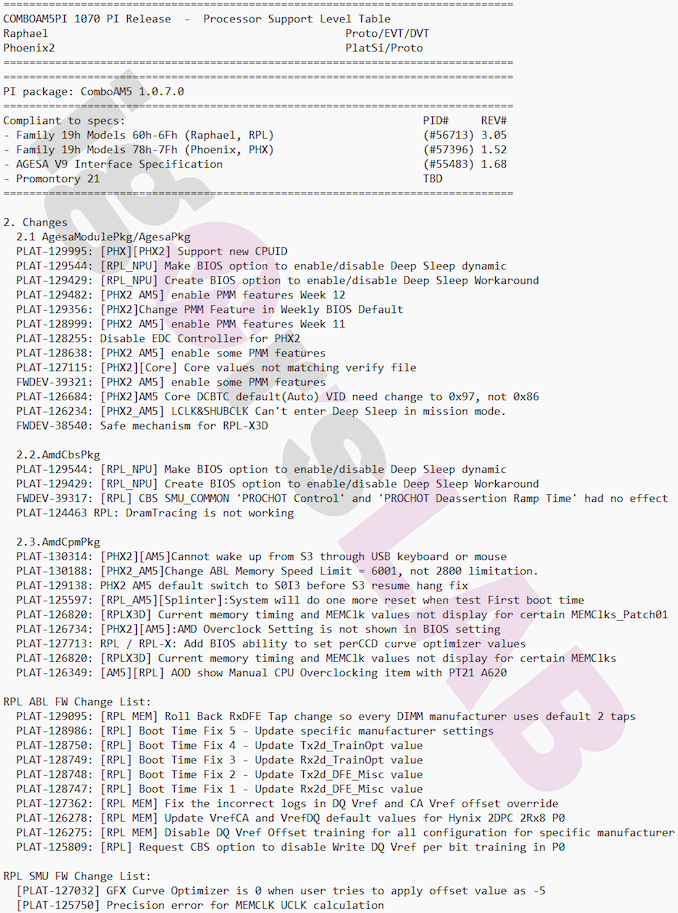
Image Credit: Igor Wallossek, Igorslab.de
The other changes coming with AGESA 1.0.0.6, according to Igor Wallosek, the Editor-in-chief of Igorslab.de, AMD has also added two new PROCHOT entries that point directly to combating overheating. PROCHOT essentially means Processor Hot, and it is a controlled mechanism that is designed to protect the processor from overheating. There are two implementations here. The first is the PROCHOT Control mechanism which is precisely what it says on the tin. When the CPU hits a defined value, the component sends a PROCHOT Control signal, and the CPU draws less power to try and mitigate temperatures and reduce the risk of damage.
The second mechanism is PROCHOT Deassertion Ramp Time, which dictates how long a processor can ramp up the power after the initial PROCHOT Control signal has been disabled. Essentially, PROCHOT Deassertion Ramp is the time it takes for the processor to get back up to normal parameters, and different variables, including cooling, the aggressiveness of said cooling, and general heat dissipation quality, can dictate this time. If the processor is inadequately cooled, this can result in a longer deassertion ramp time, whereas more aggressive heat dissipation methods should theoretically allow for a quicker ramp-up time.
The Story So Far: Gamers Nexus Deep-Dive - The Ryzen 7000 CORE Fundamental Issues
Before the rollout of new firmware, Steve Burke, the Editor-in-Chief of Gamers Nexus, and his team investigated the issues in-depth, including looking at the original fried hardware from Speedrookie. This includes a faulty and bulged out Ryzen 7 7800X3D processor and his burnt ASUS ROG STRIX X670E E Gaming motherboard. Instead of RMA'ing the hardware, Steve Burke reached out to the user and offered to buy the hardware from him, minimizing the RMA lead time and allowing Speedrookie to purchase new hardware.
The 38:46 long video is a very good watch, and we certainly recommend that users watch this, especially for those more interested in the inner workings (or issues) of the Ryzen 7000X3D and 7000 series processors. To summarize Steve's findings, we took away the following points:
- AMD Ryzen 7000X3D CPUs are shutting down too late to mitigate physical damage.
- ASRock, GIGABYTE, and MSI have a 116°C thermal trip point, and ASUS has 106°C, but sometimes didn't work as intended.
- The thermal cut-off for Ryzen 7000X3D is supposed to be 106°C and 116°C for Ryzen 7000.
- AMD EXPO enabled on ASUS is 1.35V on SoC voltage up until BIOS 1202 (AGESA 1.0.0.6).
- ASUS's SoC Voltage settings were/are too high.
- The AGESA firmware rollout has been nothing short of chaos at this point.
- AMD is offering RMA (paying shipping both ways) on killed CPUs, even if EXPO has been used (at least in the US)
- No word on if motherboard vendors will honor the warranty (at the time of writing)
While Steve and his team at Gamers Nexus have gone deep into uncovering the root causes of the problem, one thing remains abundantly clear: the issue is not just one that relates to SoC voltage. There has certainly been some confusion between AMD themselves and its motherboard partners in implementing the appropriate failsafe to prevent the CPU (and motherboard socket, for that matter) from burning into oblivion.
The other problem relates to ASUS here, with a more aggressive implementation of its SoC voltages, which Gamers Nexus confirmed in their testing as running too high. Before the AGESA firmware (1.0.0.6) update through BIOS version 1202, ASUS was overshooting SoC voltage by 0.05 V over AMD's newly imposed SoC voltage limit of 1.3 V.
Image Credit: Gamers Nexus
Soldering leads and connecting the motherboard to a digital multimeter, a 1.35 V SoC setting within the ASUS firmware (and with EXPO enabled) resulted in an observed 1.398 V from an SoC pad. This was typically even higher when probed at the choke, at an eye-watering 1.42 V. This fundamentally poses a problem that ASUS's firmware and the SoC rails themselves aren't cohabiting well with each other. An additional 0.05 V on top of the recommended 1.30 V is a lot, to say the least, but adding an extra 0.05 V on top of that can undoubtedly lead to dielectric degradation and possibly lead to dead CPUs and burnt motherboard sockets.
Doing some preliminary testing on the effect of SoC voltage on stability on the latest AGESA 1.0.0.7 (BETA) firmware, our G.Skill DDR5-6000 kit of DDR5 memory (2 x 16 GB) on the ASRock X670E Taichi would automatically preset 1.30 V on the SoC when applying the EXPO memory profile. To elaborate, unfortunately, we tried 1.15 V, which was a no-go, and even 1.20 V was a no-go. We eventually settled on 1.25 V on the SoC for this kit and our Ryzen 9 7950X3D, and we found stability in memory-intensive benchmarks was solid.
Perhaps one of the biggest things to come outside of Gamers Nexus's testing was that AMD is now offering RMA support for users who have used EXPO memory profiles, something which normally voids the warranty on AMD's processors. Whether or not other regions intend to honor these RMA requests hasn't been confirmed, but it's unlikely to be an issue.
Still, it's a good gesture for users with damaged CPUs from an issue that is entirely not their fault. Motherboard vendors, on the other hand, operate within their policies and parameters, and it may be trickier getting an RMA on a damaged motherboard simply because AMD doesn't control motherboard vendors' RMA policies. We would hope in good faith that motherboard vendors will honor the warranty in instances of these burnout issues, but we cannot confirm if they will at this time.
Our Testing: Methodology, Test Setup, and Hardware
To summarize the reason for testing AMD's AGESA firmware, we aren't trying to replicate burning our Ryzen 7000X3D samples – enough processors have already been sacrificed for science. For that matter, we certainly didn't see or smell any smoke coming from our ASRock X670E Taichi during testing, so we'll take that as a good sign.
Our purpose for testing is to highlight any differences or variations in parameters and power-related elements coming from AMD's latest AGESA packages. This includes looking at rails like SoC voltage and Package Power Tracking (PPT) output from the AM5 CPU socket. As AMD has dialed down what users and motherboard vendors can apply in regards to SoC voltage to 1.30 V, it's worth noting that all of ASRock's firmware we've tested on the X670E Taichi in this piece automatically sets SoC voltage to 1.30 V. While we don't have the necessary tools and equipment to solder leads to the motherboard to observe 'physical' voltages, we are relying on HWInfo's reporting prowess, as well as looking at multiple temperatures.
We also did some in-house stability testing against the new SoC voltage limits, running a fresh batch of tests on our Ryzen 9 7950X3D paired with a G.Skill DDR5-6000 (2 x 16 GB) memory kit with its AMD EXPO memory profile enabled. We found that things weren't stable until we applied 1.25 V on the SoC voltage within the firmware. Hitting up to 1.25V on the SoC, our kit was rock solid, even in memory-intensive workloads and benchmarks.
That has been our focus, trying to push the memory as hard as we can to ensure complete stability. A lot of the fanfare surrounding the issue, on the whole, has been unfairly put on AMD's EXPO profiles as being one of the causes; it is not. We know that CPU-intensive workloads will generate more heat, but that isn't what we've been looking at investigating. We're looking for variations in current and power between the different firmware versions to see if AMD (and ASRock) has made optimizations within its framework to reduce these factors, with current, or more specifically over current and the integrated failsafes being bypassed, which is one of the key concerns in the burnouts.
Our test bench for our AGESA (AM5) update testing is as follows:
| AMD Ryzen 7950X3D AGESA Test Platform | |
| CPU | Ryzen 9 7950X3D ($699) 16 Cores, 32 Threads 120 W TDP |
| Motherboard | ASRock X670E Taichi (BIOS 1.18, 1.21 & 1.24.AS02) |
| Memory | G.Skill Trident Z5 Neo 2x16 GB DDR5-5200 (JEDEC Default) DDR5-6000 CL34 (EXPO Profile) |
| Cooling | EK-AIO Elite 360 D-RGB 360 mm AIO |
| Storage | SK Hynix 2TB Platinum P41 PCIe 4.0 x4 NMve |
| Power Supply | Corsair HX1000 |
| GPUs | AMD Radeon RX 6950 XT, Driver 31.0.12019 |
| Operating Systems | Windows 11 22H2 |
For our choice of workloads, we're relying on the Memory Test Suite from Openbenchmarking.org via Phoronix to implement our memory-intensive workloads. Although some of these workloads aren't optimized and don't run on Windows, we used the CacheBench benchmark, which uses multiple data types across read, write, modify, and read/write/modify combined. As part of the LLCbench low-level architectural characterization benchmark suite, CacheBench is designed to test memory and cache bandwidth performance and relies on a compilation of C++ Toolchains and compilers.
Read on for more analysis.
AGESA 1.0.0.5c to 1.0.0.7: Differences With ASRock's X670E Taichi Firmware
Before we head into the testing, we figured it would be a good idea to highlight what we found different (if anything) within the BIOS of ASRock's X670E Taichi motherboard when updating the firmware from each successive version. Although nothing has changed from a GUI perspective, we can at least see some of the main settings that ASRock is presetting once AMD's EXPO memory profiles are enabled.
_575px.jpg)
Screenshot of ASRock X670E Taichi UEFI firmware: BIOS 1.18 (AGESA 1.0.0.5c)
While nothing has changed in regards to the GUI, the most significant change from going from AMD's initial Ryzen 7000X3D-enabled BIOS is that users were able to set crazy levels of SoC voltage; the X670E Taichi would let us put 2.50 V on the SoC, which is ridiculously dangerous. As a reminder, the Ryzen 7000X3D chips are non-overclockable from a core frequency and VCore perspective, though they do support AMD EXPO memory profiles.
ASRock is clearly overshooting SoC voltage to ensure stability for users. When applying AMD EXPO on supported DRAM, all of ASRock's X670E Taichi firmware variants from AGESA 1.0.0.5c to the latest BETA AGESA 1.0.0.7 (BETA) variant, the firmware would automatically apply 1.30 V to the SoC voltage, regardless of what memory frequency is used. If users opt for a lower spec kit such as DDR5-6000 with EXPO, applying 1.30 V is a little overkill, as we found it made no difference to stability until we went below 1.25 V on the SoC voltage.
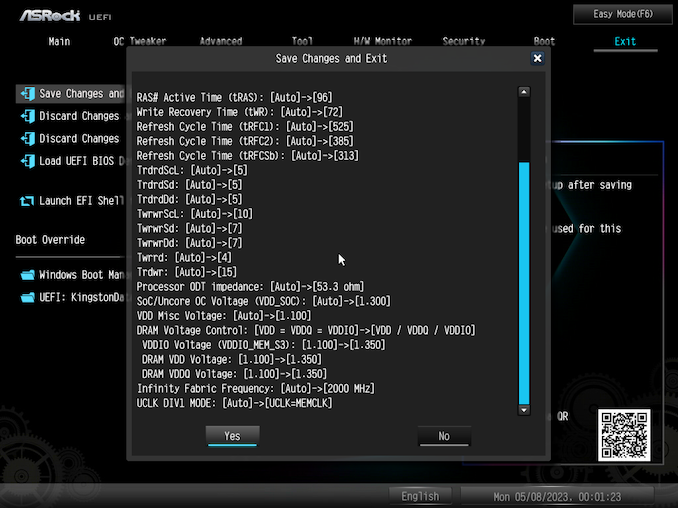
ASRock X670E Taichi firmware applying changes when using EXPO on our DDR5-6000 EXPO kit.
Looking at the changes that applying memory with an AMD EXPO profile has on the settings, we can see that ASRock automatically changes some key voltage settings relating to SoC, VDDIO, DRAM VDD, and DRAM VDDQ. As we previously mentioned, ASRock automatically applies 1.30 V to the SoC voltage when you use EXPO memory profiles, or even XMP 3.0 profiles, as we found out. The VDD misc voltage was set to 1.10 V from auto, with the DRAM voltage (DRAM VDD/VDDQ) increasing to 1.350 V from 1.10 V. As per the memory specifications and how AMD's Infinity Fabric works, the firmware automatically applied 2000 MHz for Infinity Fabric and changed the UCLK DIV from auto to equal the MEMCLK.
AMD AGESA 1.0.0.5c Up to 1.0.0.7: Analysis, Testing For Differentials
For our analysis of the changes that AMD's updated AGESA firmware has on specific variables when put under heavy and intensive memory-focused workloads, we'll be splitting the sections into two; memory at the JEDEC default specifications (settings on auto) and with EXPO enabled (DDR5-6000 CL34).
G.Skill Trident Z5 at DDR5-5200 (JEDEC) Settings
The key variables we'll be focusing on include the following:
- Peak Temperatures across the CPU die, CPU CCD1 (3D V-Cache), and CPU CCD2 (in °C)
- Peak Voltages including CPU VDDCR/VDD, CPU VDDR_SoC (SoC Voltage)
- Peak Current, including CPU Core current and SoC current (in amps)
- Peak Power, including CPU PPT (from the AM5 socket) and SoC power
In our results, the CPU die temp max average is an average of both CCD1, CCD2, core temperatures and L3 cache temperatures. This isn't to be confused with the average of the CPU die temp average.
Starting with peak temperatures across both CCDs and the die, going from AGESA 1.0.0.5c to AGESA 1.0.0.7 (BETA), we can see that the CCD2 (non-V-Cache) was noticeably higher by just under 25%. The CCD (1) with 3D V-Cache was relatively consistent regarding peak temperatures, with a jump of just 2%. Overall, the CPU die temp, as with CCD1, was higher due to the different core temperatures on CCD2.
We can see that going to AGESA 1.0.0.6 from 1.0.0.5c resulted in slightly lower temperatures across all of the CCDs and overall die temp, but the latest AGESA 1.0.0.7 (BETA) (at the time of writing) was the hottest of all. One possible reason for the higher temperatures on AGESA 1.0.0.7 is that reducing power from the one component of the CPU, in this case, the SoC allows the actual Zen 4 cores slightly more headroom in terms of power.
Looking at the average temperatures across CCD1 and CCD2 and the overall die temperature, we can see that there wasn't much variance between the different AGESA versions. Even on AGESA 1.0.0.7 with a higher temperature peak, the average is much more in line with the other AGESA versions.
Focusing on voltages, including CPU VDDCR_VDD (memory voltage) and CPU VDDR_SoC voltages, we can see they are consistently within acceptable margins. While we're not focused on CPU VCore as it's well within specification, and hasn't been an issue as the Ryzen 7000X3D series chips are core frequency/voltage locked, the SoC and memory voltages are well within expected levels in line with our G.Skill Trident Z5 Neo DDR5-6000 memory's specifications.
Although we observed higher temperatures across the board on AGESA 1.0.0.7 (BETA) without AMD's EXPO enabled, we can see that AGESA 1.0.0.5c's current peaked higher. While sustained current and voltages can spike higher than the averages, they aren't sustained and shouldn't be of concern, at least not from our testing.
Focusing on the averages of both the SoC and CPU Core currents, we can see that AGESA 1.0.0.6 is slightly more reserved than the initial Ryzen 7000X3D series launch firmware and the latest AGESA 1.0.0.7 (BETA).
The actual power values monitored using HWInfo show that AGESA 1.0.0.7 (BETA) has a higher peak power from the socket (PPT) than the two other AGESA versions. As we've seen from our testing, AGESA 1.0.0.6 with our ASRock X670E Taichi is more conservative on current and power, so temperatures are lower across the board. Pulling more power from the socket with AGESA 1.0.0.7 (BETA) and our Ryzen 9 7950X3D does explain why temperatures are higher, both at peak and average.
Our testing shows that AMD's AGESA 1.0.0.7 (BETA) is consistent with other AGESA firmware versions at default memory settings. Still, we can see an increase in power draw and temperatures, at least on the ASRock X670E Taichi.
G.Skill Trident Z5 at DDR5-6000 (EXPO Enabled) Settings
Now onto our testing with the AMD EXPO memory profile enabled on our G.Skill Trident Z5 Neo DDR5-6000 CL34 kit. We've added another variable, with our DDR5-6000 kit also running with an applied SoC voltage of 1.25 V in the firmware.
A closer look at peak temperatures shows a slight variation between all three AGESA firmware variants. Using AMD AGESA 1.0.0.7 (BETA) with 1.25V on the SoC voltage, CCD2 peaked at 55.5°C, the CCD without the 3D V-Cache. This was a noticeably higher spike than expected, given that SoC voltage was inherently lower than the other runs (1.30 V on the SoC).
Interestingly, the initial launch BIOS (AGESA 1.0.0.5c) for Ryzen 7000X3D processors ran with the lowest temperature on CCD2, and we observed the lowest spike in temps on CCD1 (3D V-Cache) too. Looking at the maximum CPU die temperature average, all were within quite acceptable margins, with nothing noteworthy in this regard and nothing out of the ordinary.
Moving to the average temperatures, we see things are much more balanced between the three AMD AGESA firmware versions. AGESA 1.0.0.7 (BETA) at 1.25 V on the SoC voltage still averaged slightly warmer on the non-3D V-Cache enabled CCD than on AGESA 1.0.0.5c, which was less on average compared to AGESA 1.0.0.6.
Concentrating on peak voltages across both the memory and CPU SoC voltages, we can see that AMD AGESA 1.0.0.6 peaked slightly higher on memory voltage than the other revisions. SoC voltage is consistent across all three AGESA variants at 1.289, showing that ASRock's firmware automatically setting 1.30 V for SoC is working well. At 1.25 V on AGESA 1.0.0.7 (BETA), our SoC voltage reading topped out at 1.239 V, which shows a bit of negative VDroop, a positive in this case.
Again, AGESA 1.0.0.6 is operating with more courage as it pulls more amps than other versions; it's interestingly peaking at a higher current on the SoC voltage than the firmware before it, AGESA 1.0.0.6. It would have been thought that AMD's quick fix BIOS to address SoC voltages would peak at lower variables, and it peaks around half an amp higher than the latest AGESA 1.0.0.7 (BETA) firmware.
Even setting 1.25 V on the SoC, the amperage pulled from the rail responsible for the SoC is lower than 1.30 V, which is expected as less power is fed through it. Although we didn't experience any reported problems in our testing, CPU core current spiked higher on AGESA 1.0.0.6 than the other versions.
Focusing on average amps drawn from the SoC, things on the SoC balance back to expected levels, although there is not much variation comparing all three AGESA firmware. On average, with AGESA 1.0.0.6 and 1.0.0.7, we can see that the average CPU core current is noticeably higher than AGESA 1.0.0.5c, which is the initial launch BIOS for the X670E Taichi for Ryzen's 7000X3D series.
Lastly, the peak power output with AMD's EXPO memory profile enabled on our Ryzen 9 7950X3D with the ASRock X670E Taichi. As we can see, AMD AGESA 1.0.0.6 peaked out over 5 W higher on the AM5 socket than the other versions, and AGESA 1.0.0.5c seems to be the most conservative regarding this. For SoC power output, AGESA 1.0.0.6 spikes higher on power than the different versions, which could be one of the reasons that AMD replaced AGESA 1.0.0.6 so quickly.
Conclusion
Although the fundamental issue is clear in that some users are experiencing burnout of their Ryzen 7000X3D processors, the issue isn't limited to just Zen 4-based SKUs with 3D V-Cache. The problem could potentially lay at several doors, at a silicon level, the motherboard's implementation of SoC voltage, and, in some cases, an uncontrollable current rampaging through the chip and socket. As a highly destructive issue, which isn't only killing the processor, but in some cases, taking the motherboard socket with it, AMD and motherboard vendors are experiencing a tumultuous time in diagnosing and implementing a solid fix to resolve these issues.
While writing this article, Gamers Nexus posted a new video where they sent the failed CPU to an external laboratory to investigate the issue. The 'failure analysis report,' as GN is calling it, uses an external and unnamed lab to do a variety of testing including and not limited to, C-mode scanning acoustic microscopy, X-ray analysis, a 3D CT scan, high magnification microscopy, and scanning using an electron microscope Xsec.
The biggest takeaway from Gamers Nexus's most recent external lab-based analysis is that multiple manufacturing defects could have caused the issue. The lab in question couldn't identify the issues specifically, and much of it at this point is based on assumptions; to assume isn't a scientific method to establish anything from, only opinions.
From our testing, we set out not to look at trying to replicate the burnout issue but to try and understand what AMD's AGESA updates are doing to different variables such as current, voltage, and power, typically focusing on the SoC, as that's what AMD has primarily concentrated on capping to try and alleviate the issues.
Looking at an overall view of the peak current we experienced with our AMD Ryzen 9 7950X3D with ASRock's X670E Taichi motherboard, we can see that everything is fundamentally well within control; this can be taken one of two ways. The first is that ASRock has done things correctly by applying 1.30 V to the SoC by default when applying memory overclocks via AMD's EXPO and XMP profiles. The second is that other vendors haven't been getting things as right, especially with reports of ASUS boards before the new AGESA firmware having OCP (over current protection) failures, resulting in too much current going through the chip.
In our testing and focusing primarily on the amperage levels, we can see that the initial Ryzen 7000X3D firmware, AGESA 1.0.0.5c, did spike higher than all the other firmware in terms of SoC current. This is the case at default memory settings and with AMD EXPO applied to our G.Skill Trident Z5 Neo DDR5-6000 memory kit. Despite the higher peaks in SoC current, the peak didn't seem troublesome, but having a lower current is always advantageous in helping reduce overall power, heat, and in this case, not overloading and frying CPUs.
In our testing, the latest (at the time of writing) AGESA 1.0.0.7 (BETA) firmware had the lowest peak SoC current at default settings and the lowest amperage with EXPO applied. By setting 1.25 V instead of ASRock's 1.30 V default on the SoC voltage, we managed to lower the peak SoC amperage.
Turning to the average current through the SoC rails, AMD's AGESA 1.0.0.5c, as expected, has the highest average. AMD AGESA 1.0.0.7 (BETA), the newest at the time of writing, has the lowest average current levels. We reduced the average current by around 7% by setting 1.25 V on the SoC voltage instead of relying on ASRock's 'one size to fit all' approach. Interestingly, despite having the highest peak SoC current, AGESA 1.0.0.6 has a very marginally lower average current through the SoC, by 0.01 A.
Final Words: Speculations on Ryzen 7000 Burnout Issue, But Nothing Conclusive
The biggest problem is that AMD's Ryzen 7000 series processors (mainly X3D) are burning up inside the socket, frying, and sometimes totaling the AM5 socket. This is a big issue that AMD and its partners still need to address 'properly.' It's not that they aren't working tirelessly to rectify the problem, as it released three AGESA firmware updates in just over a month. AMD's most significant strategy to fix the issue has been to curtail SoC voltage, which, as it has been found by Gamers Nexus, is at the root of the problem; it's not the only problem, but rampaging and unattended SoC current is a notable cause for the destruction.
Perhaps one of the other core problems with all of these issues is all of the speculation. We aren't interested in speculation because, as good as it is sometimes to speculate, assumptions can run wild. Even when Gamers Nexus sent one of their dead Ryzen 7000X3D CPUs to an external lab, the unnamed lab didn't come up with anything particularly conclusive. While it is clear there's a lot of speculation and analysis that's already been done, as well as more likely to come shortly until the root cause is identified, the buck stops with AMD and its partners.
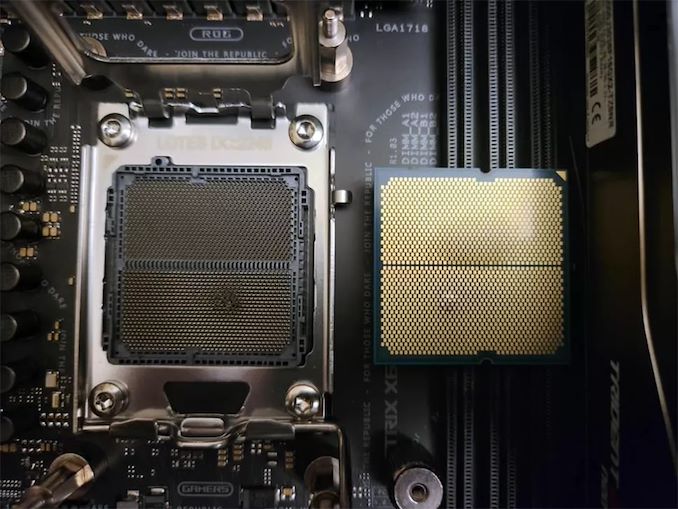
Image Credit: Speedrookie/Reddit
From our testing, we can highlight clearly that we didn't experience any issues with the ASRock X670E Taichi, nor did we find any cause for concern. If anything, we can see one particular trend throughout our testing, and we're making this claim based on our testing; AMD's AGESA 1.0.0.6 looks rushed, and that's certainly not without benefit to users and scrutiny. It benefits users by not allowing them to accidentally enable too much SoC voltage to the chip, which in the case of ASRock's X670E Taichi on AGESA 1.0.0.5c, allowed us to set 2.50 V.
With the second BIOS fix through AGESA 1.0.0.7 (BETA), we observed more reserved SoC current, peak power from the SoC and more conservative average values. This is a step in the right direction in terms of lowering the likelihood that SoC voltage and current are going to kill the CPU. While AMD is rolling out its AGESA firmware, it's fundamental to note that these revisions are listed as BETA, which gives AMD room to improve for a comprehensively tested and tweaked firmware designed to alleviate all of the issues above.
Exposure to higher voltage and heat can energize the atoms and molecules of a dielectric material and trigger chemical reactions that break down its structure, leading to dielectric degradation. Common mechanisms of degradation include thermal oxidation and electrical breakdown, which respectively create defects and conductivity in the material. The end result is the loss of insulation properties, increased leakage currents, and eventual material failure.
In the case of the Ryzen 7000/X3D series, the large current and heat are accelerating dielectric degradation and are not only weakening the integrity of the silicon and the internals but it's effectively damaging them beyond a point of no return. This is why it's important to operate with lower voltages which in turn lowers current, lowers total power output, and in turn, lowers temperatures. Overshooting so high on something with a fragile component added through vias as a 3D packaged die is, isn't likely to turn out well, at least not from a theoretical standpoint.
It's expected that AMD is going to soon roll out a new fully-fledged AGESA firmware to mitigate these issues. Which, according to Gamers Nexus, is likely a result of failing to implement proper fail-safes in over current protection (OCP), thereby in some cases letting current run rampant through the CPU. Whether this is down to motherboard vendors such as ASUS, GIGABYTE, and ASRock, or is something under AMD's umbrella, is speculation at this point.
Our testing shows that the latest AGESA 1.0.0.7 (BETA) (BETA) firmware is undoubtedly better overall than the initial firmware. However, the news that AMD openSIL is set to replace AGESA firmware in 2026 is another variable entirely. The key takeaway is that, at least on the ASRock X670E Taichi, things are working as they should be with AGESA 1.0.0.7 (BETA), and we look forward to a full release (non-BETA) of their latest AGESA in the coming weeks.

